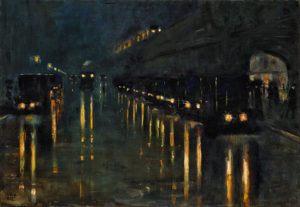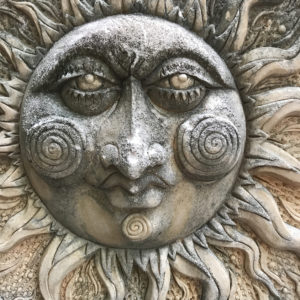And now this 15th of July comes St. Swithin’s Day. It is a traditional weather marker concerning rain, based on the old story of St. Swithin, the weeping saint. St. Swithin was a 9th century Anglo-Saxon bishop of Winchester. The source of the weeping comes from after his earthly life, for it was the good bishop’s wish to be buried in the churchyard and not in the chancel of the church, as was the custom for bishops. His wishes were followed when he died, but after his canonization, the monks decided the open churchyard was a rather disgraceful place for a saint to be buried, and so on the 15th of July in 971, they planned to move the relics of St. Swithin indoors to the choir, in a solemn procession. A great downpour began during the procession, though, and continued for forty days. The monks took this is a sign from St. Swithin himself, and so they let him be there in the churchyard, although they did eventually erect a chapel over his grave.
Now, the story goes, that “St. Swithin’s Day if thou dost rain, For forty days it will remain; St. Swithin’s Day if thou be fair, For forty days ’twill rain nae mair.” There is, as well, an old saying that when it rains on St. Swithin’s Day, the saint is blessing the apples. Here are a few lines from Poor Robin’s Almanack, July 1697:
In this month is St Swithin’s Day;
On which, if that it rain, they say
Full forty days after it will,
Or more or less, some rain distill.
This Swithin was a Saint, I trow,
And Winchester’s Bishop also.
Who in his time did many a feat,
As Popish legends do repeat:
A woman having broke her eggs
By stumbling at another’s legs,
For which she made a wofull cry,
St Swithin chanc’d for to come by,
Who made them all as sound, or more
Than ever that they were before.
But whether this were so or no
‘Tis more than you or I do know:
Better it is to rise betime,
And to make hay while sun doth shine,
Than to believe in tales and lies
Which idle monks and friars devise.
Poor Robin was not a fan of the monks and friars (or the Catholics), to be sure, and obviously valued hard work more than a good story. One last mention of the legend: John Gay, in his poem “Trivia,” gives a few lines to our weeping saint:
How, if on Swithin’s Feast the welkin hours,
And every penthouse streams with hasty showers,
Twice twenty days shall clouds their fleeces drain,
And wash the pavements with incessant rain.
In Britain, the land of Swithin, and here in Lake Worth, too, chances are good this time of year that if it indeed doth rain on St. Swithin’s Day then we will have forty days more of the same. Here it is our rainy season. It does not rain incessantly, but it is pretty consistent this time of year, and most of our summer days include at least a bit of water falling from the sky, typically in the form of early morning coastal showers or afternoon thunderstorms that build over the Everglades and rush toward the coast. We are well aware of our pal Swithin. Weep as you will, good bishop. There’s nothing wrong with a good cry every now and then.
Image: Hochbahnhof Bülowstraße bei Nacht by Ury. Oil on canvas, 1922 [Public domain] via Wikimedia Commons.


